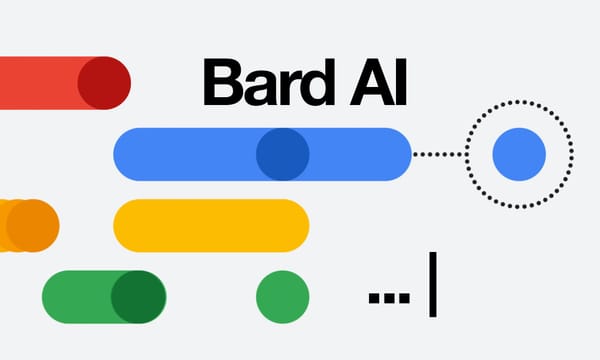[Note: Bard is now Gemini]
As finance professionals, we swim in an ocean of numbers, and deciphering these digits is both our challenge and our craft. However, the way we view, understand, and present these figures is changing, thanks to the transformative power of AI.
We’ve seen the rising growth of finance professionals using ChatGPT in Excel and now, with Google Bard on the scene, we’re all left wondering if Bard can assist us even better than ChatGPT. Can it help create accurate financial reports? How about analyzing large datasets?
These are just some of the questions we answer in this article, where we discuss the rise of Google Bard and how it can act as your personal assistant within your finance role.
Topics covered:
- What is Google Bard?
- What’s the difference between ChatGPT and Bard
- How to use Bard with Google Sheets
- How to use Bard with Excel
- Bard in finance
- Bard vs ChatGPT: A case study
What is Google Bard?
Google Bard is a large language model (LLM) chatbot developed by Google AI. It’s trained on a massive dataset of text and code and can generate text, translate languages, write creative content, and answer questions. You can even have a conversation with Bard directly about anything from the weather to the latest economic news and insights.
It's worth noting that Google itself calls Bard an ‘experimental conversational AI service’. According to Google, Bard seeks to…
“…combine the breadth of the world’s knowledge with the power, intelligence, and creativity of our large language models. It draws on information from the web to provide fresh, high-quality responses. Bard can be an outlet for creativity and a launchpad for curiosity.”
Google Bard is a powerful new tool, but is it better for streamlining finance tasks than ChatGPT?
That remains to be seen. For now, though, let’s take a closer look at the main differences between the two artificial intelligence chatbots.
ChatGPT vs Bard: What’s the difference?
Google Bard and ChatGPT are both large LLMs trained on huge datasets of text and code. But they aren’t exactly the same. Below, we break down some of the main differences between the two:
1. User experience
ChatGPT and Bard are easy to navigate and provide a user-friendly experience. Just tap away at your keyboard, feed them your questions, and that's it! They'll whip up answers for you within seconds. It's a straightforward process as the simplicity of typing in your prompts means it's almost impossible to mess up.
Here is a side-by-side comparison of ChatGPT and Bard's opening screens:
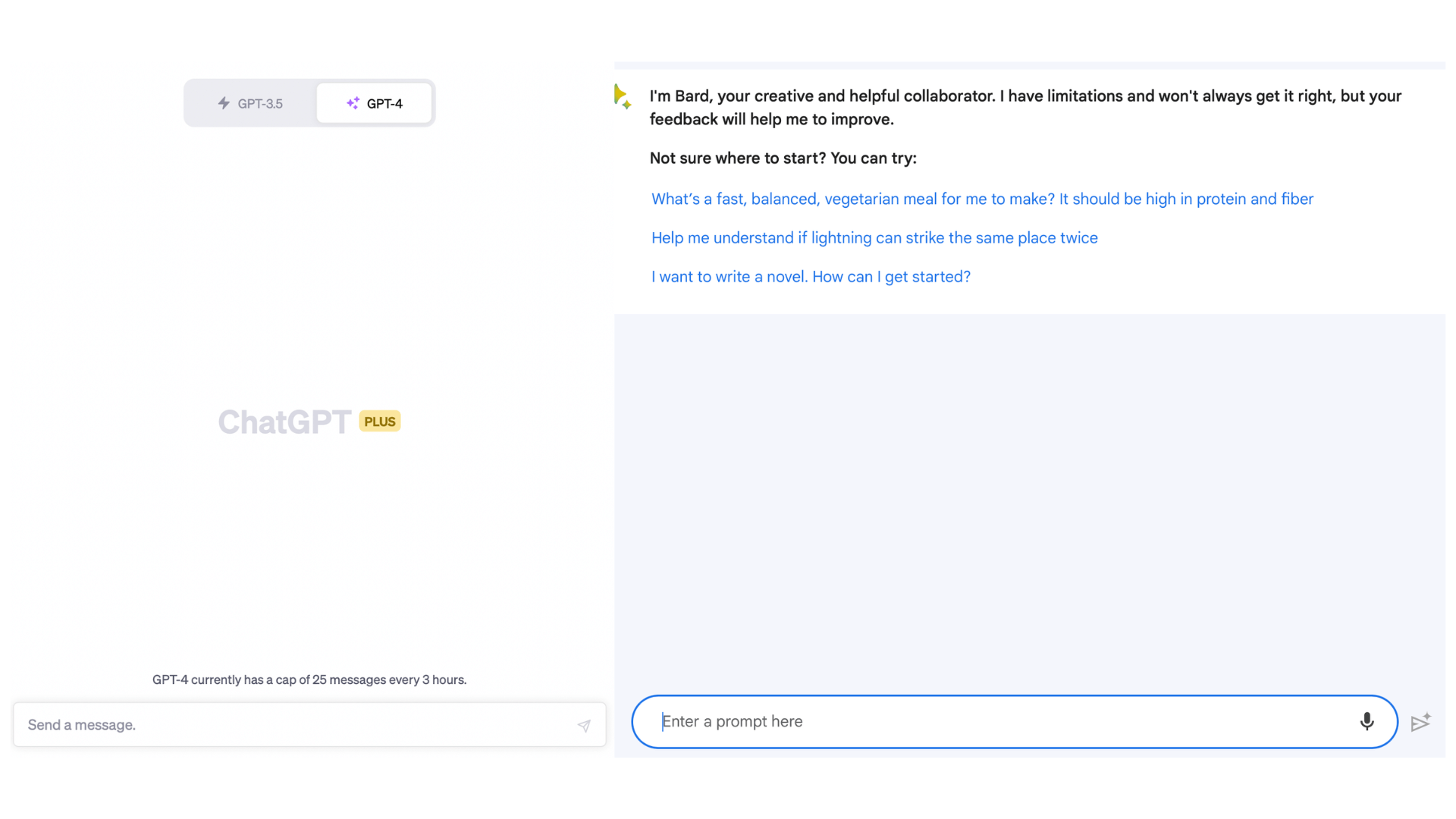
2. Accuracy
Early users claim Bard provides more accurate information than its competitor, which relies on carefully crafted prompts to generate detailed responses. As you can imagine, having more accurate information can help you make better decisions. For example, if Bard is asked to provide information on a particular stock, it can access the latest news and research to provide a more accurate assessment of the stock's value.
3. Relevance
Bard shines when it comes to unearthing the right answers to your questions but it’s still a work in progress and will need to be fact-checked to ensure relevancy and accuracy. Bard is a time-saver and can pull together relevant pertinent articles, research papers, and resources to help you as and when needed. On the other hand, ChatGPT is more adept at crafting and summarizing text in a conversational manner.
4. Training style
A lot of people don’t realize that both AI chatbots have been trained with different ‘training styles.’ This is one of the biggest differences between the two. Bard uses a "learn by doing" method called self-supervised learning. On the flip side, ChatGPT goes the traditional route with supervised learning, where it learns from data that's been labeled by us humans.
Here are some examples of how Bard learns by doing:
- When a user asks a question
- When a user asks Bard to complete a task
- When Bard interacts with users
Basically, Bard continues to learn new things about the world and how to communicate with people. It also learns new things about language, how to generate text, translate languages, write different kinds of creative content, and answer questions in an informative way.

Can you use Bard in Google Sheets?
Yes, you can use Bard in Google Sheets. Since Bard’s release, there’s been an increasing (and very vocal) demand for coding functionalities. The good news is Google listened to its users and Bard can now help with all types of programming and software development tasks.
Bard can not only help with code generation, debugging, and code explanation in more than 20 programming languages such as Python, Javascript, Typescript, and others, but it can also assist with writing functions for Google Sheets.
How to use Bard with Google Sheets
At the Google I/O 2023 conference, the search giant did a deep dive session into the Bard AI chatbot and talked about how it can be used with Google Sheets and other products such as Gmail.
You can watch the full video below (or skip ahead to 24:02 to learn more about using Bard with Google Sheets).
In the presentation, the speaker showed an example of how you can ask Bard to arrange data into a table with rows and columns (screenshots below). Here is an example of that in action:
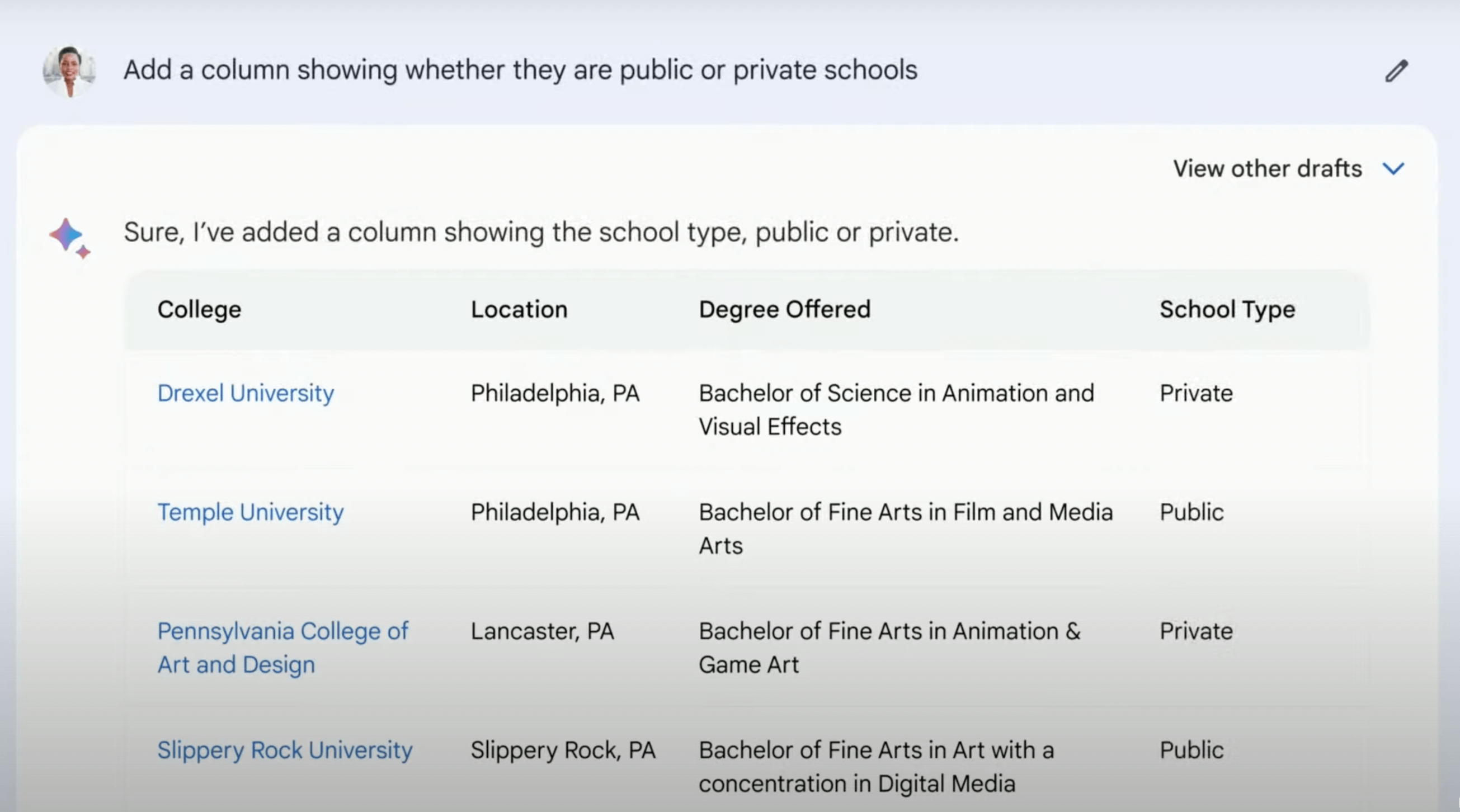
Next, the speaker explained that you'll be able to export that data directly to Google Sheets with the click of a button (bottom right on the screen in the image below).

Like clockwork, your data is suddenly organized in Sheets and you barely had to lift a finger.
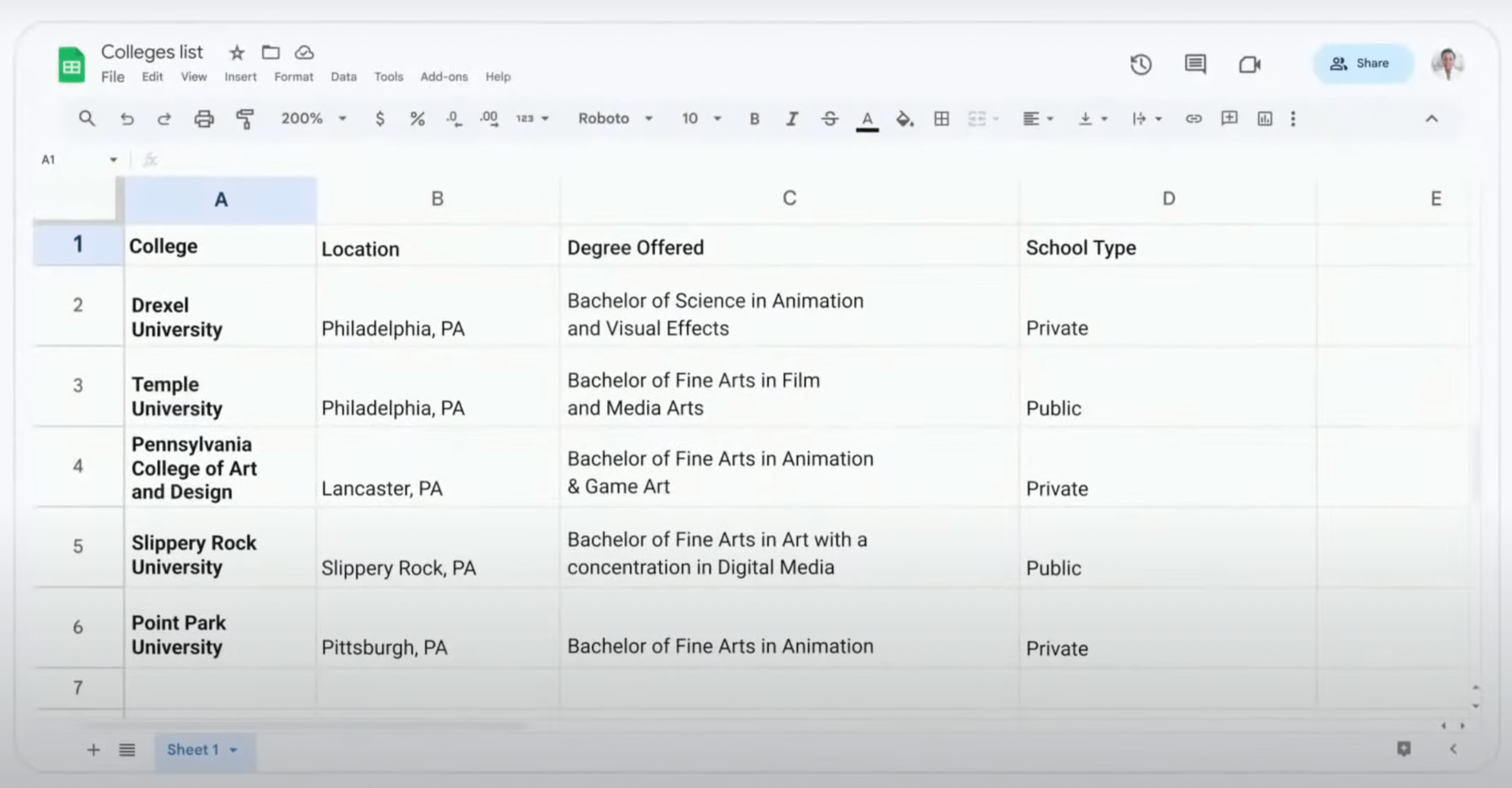
Of course, in finance, you’ll be working with a lot more complex data than comparing universities, but you get the idea.
You'll also be able to access Bard directly in Sheets via Google’s new service, ‘Duet AI for Workspace’.
"Our new 'help me organize' capability in Sheets automatically creates custom plans for tasks, projects, or any activity that you want to track or manage — simply describe what you’re trying to accomplish, and Sheets generates a plan that helps you get organized.
"Whether you’re an event team planning an annual sales conference or a manager coordinating a team offsite, Duet AI helps you create organized plans with tools that give you a running start." - Aparna Pappu, GM and Vice President, Google Workspace
For Google Sheets, the presenter used a dog-walking business as an example for the keynote. However, you can easily use the same feature to help you automate tasks, analyze data, and even generate financial reports.
Simply open a new sheet, type your request in the side panel on the right via the ‘Help me organize’ tab, and hit create (as shown in the image below from Google’s keynote):
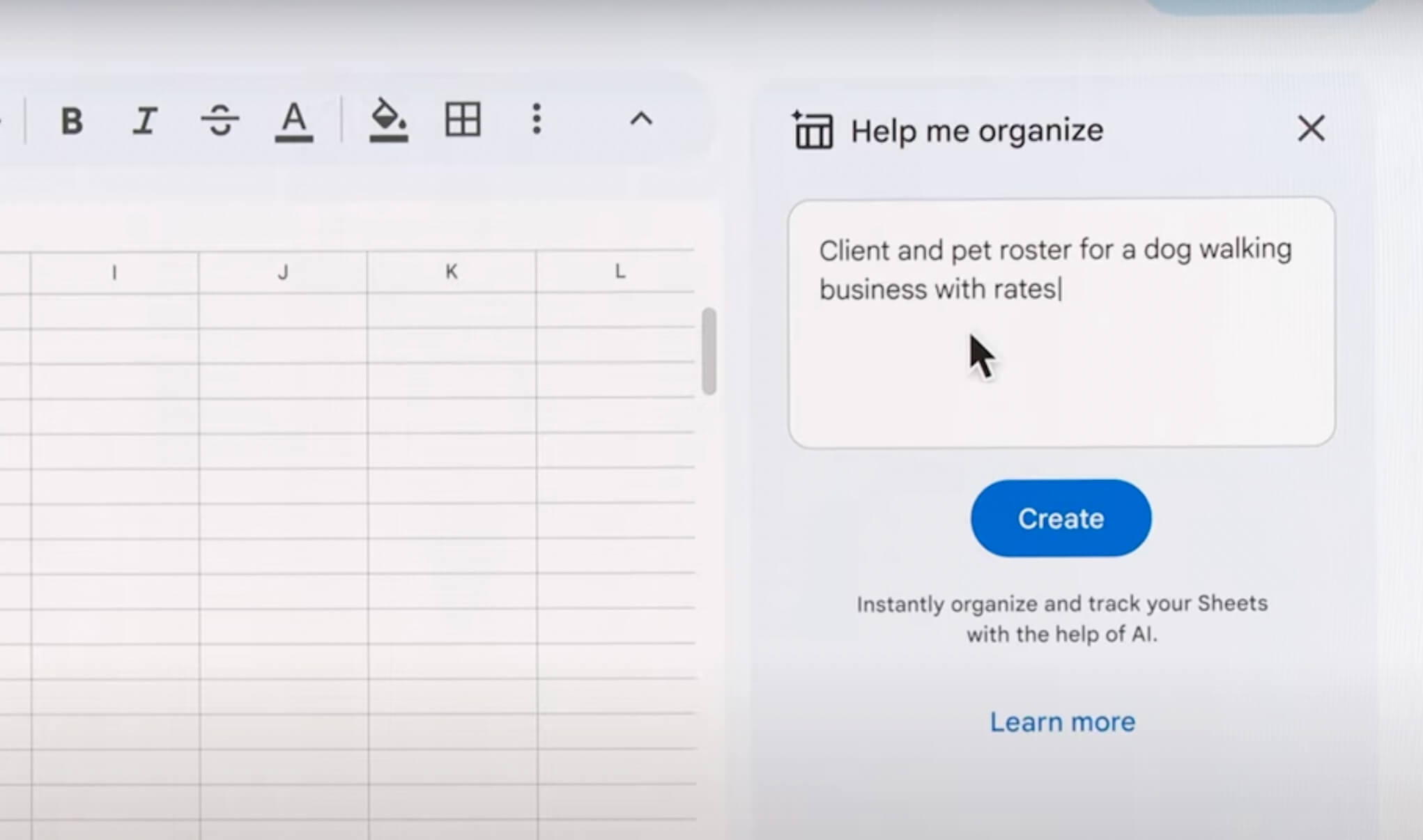
The AI model is then able to figure out what you need based on your query or prompt. In the example shown in the presentation, Bard was able to generate the following data with more relevant details.
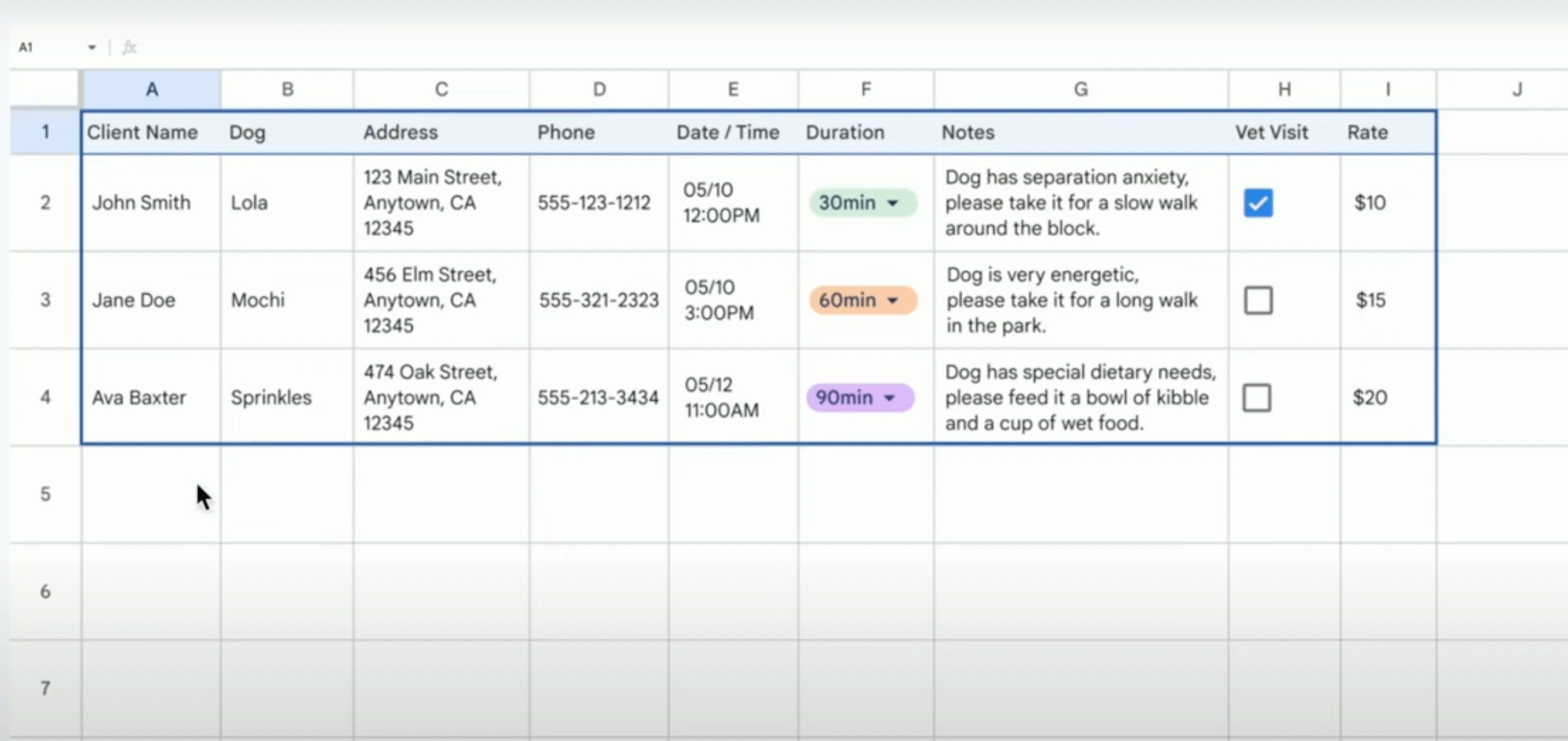
How to use Bard with Excel
While Bard isn’t integrated with Excel, you can still use it to help streamline and automate Excel tasks.
For example, you can use Bard to help generate data for Excel spreadsheets. It can generate and/or analyze specific financial data such as revenue, expenses, or profit. You can perform simple operations like calculating the average of a range of cells or visualizing data with a chart or graph.
Bard is also capable of executing more intricate analyses, including regression analysis or time series analysis.
When it comes to data formatting, Bard shines again. You can use Bard to convert text to numbers, apply styles to cells, or create hyperlinks. More advanced formatting tasks, such as creating pivot tables or macros, are also within Bard's capabilities.
Some other tasks you can use include updating formulas automatically, sending emails with attachments, creating reports, and even automating data entry or generating custom functions.
These enhanced functionalities position Bard as a valuable asset if you’re a loyal Excel user, streamlining your workflow and boosting your efficiency.
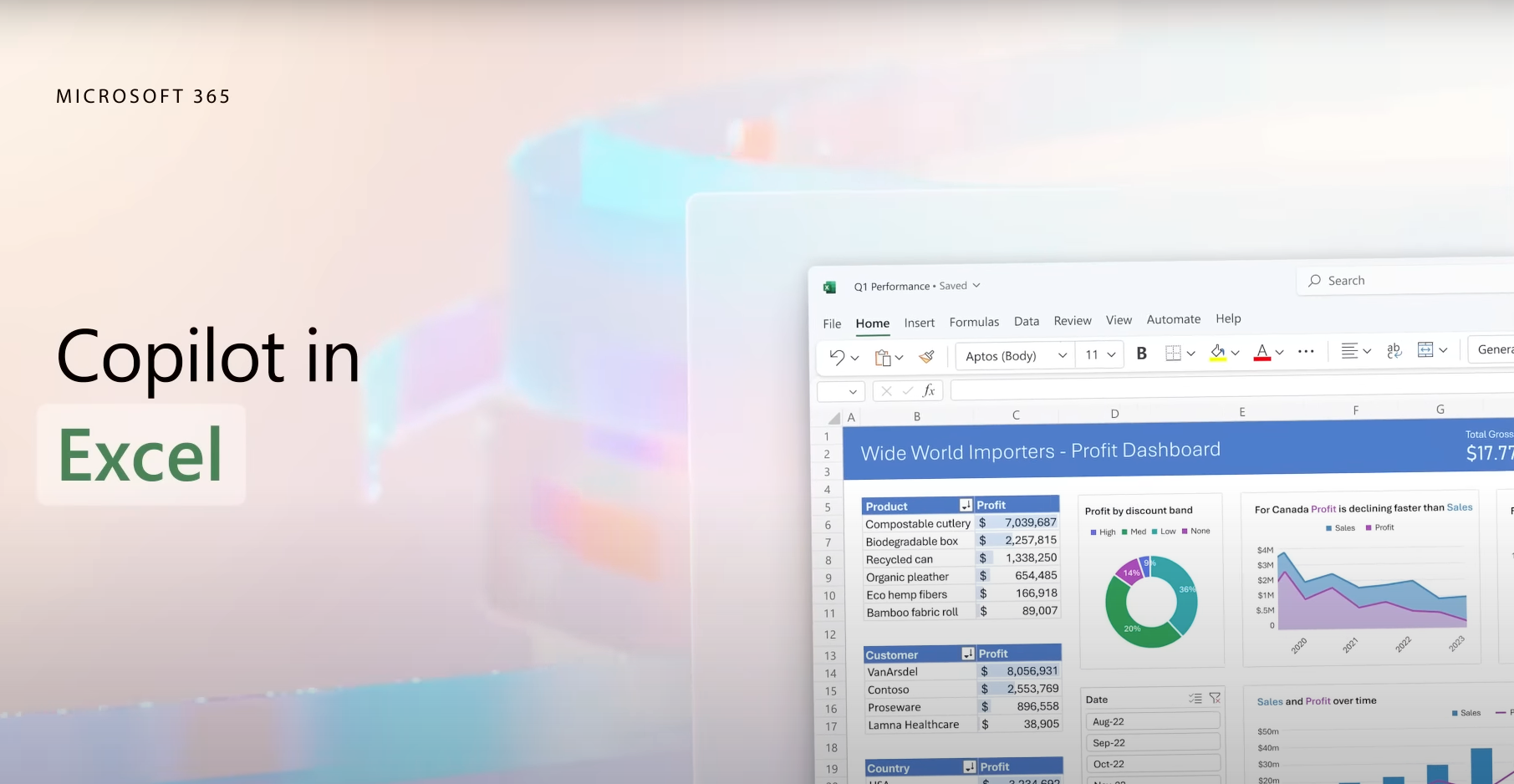
Bard in Finance
Here are some more examples of how you can use Google Bard in finance:
Data entry
Bard is cutting down hours of manual work by extracting data from documents and spreadsheets automatically. This is proving invaluable for managing large datasets, giving you that much-needed breather.
Data analysis
Bard is stepping into the shoes of an analyst by performing calculations and generating reports on the fly. It's helping finance professionals spot trends and patterns, ultimately leading to more informed decision-making.
Financial forecasting
Bard is playing the role of a financial soothsayer, generating forecasts based on historical data. This foresight is aiding professionals in planning for the future and making smarter investment choices.
Risk management
Bard is turning into a vigilant watchdog, identifying and assessing risks. This is empowering finance professionals to mitigate potential dangers and safeguard their company's assets more effectively.
Create presentations
Bard can create presentations that are clear, concise, and visually appealing. This can help you communicate financial information to stakeholders.
Write financial documents
Bard can write financial documents, such as budgets, forecasts, and financial statements. This can save you a lot of time and help them ensure that their documents are accurate and compliant.
Compliance
Lastly, Bard is serving as a compliance guide, ensuring that you're meeting all relevant regulations. This helps ensure that companies avoid potential fines and penalties, keeping their operations smooth and trouble-free.

Bard vs ChatGPT: A case study
We wanted to put the two AI giants to the test with a simple case study. So, we asked both Bard and ChatGPT the same question:
“Write an in-depth financial report (cash flow statement) based on Netflix's latest quarterly earnings.”
With this prompt, we were able to perform a comparative analysis between the two AI chatbots to compare their responses to see which one provided a more accurate and contextually relevant answer.
Here’s what ChatGPT churned out:
As expected, ChatGPT let us know about its knowledge limits and the fact it can only access data up until September 2021. However, it went on to guide us on how to write a cash flow statement report based on a company's quarterly earnings. It also provided blank spaces for us to fill in:
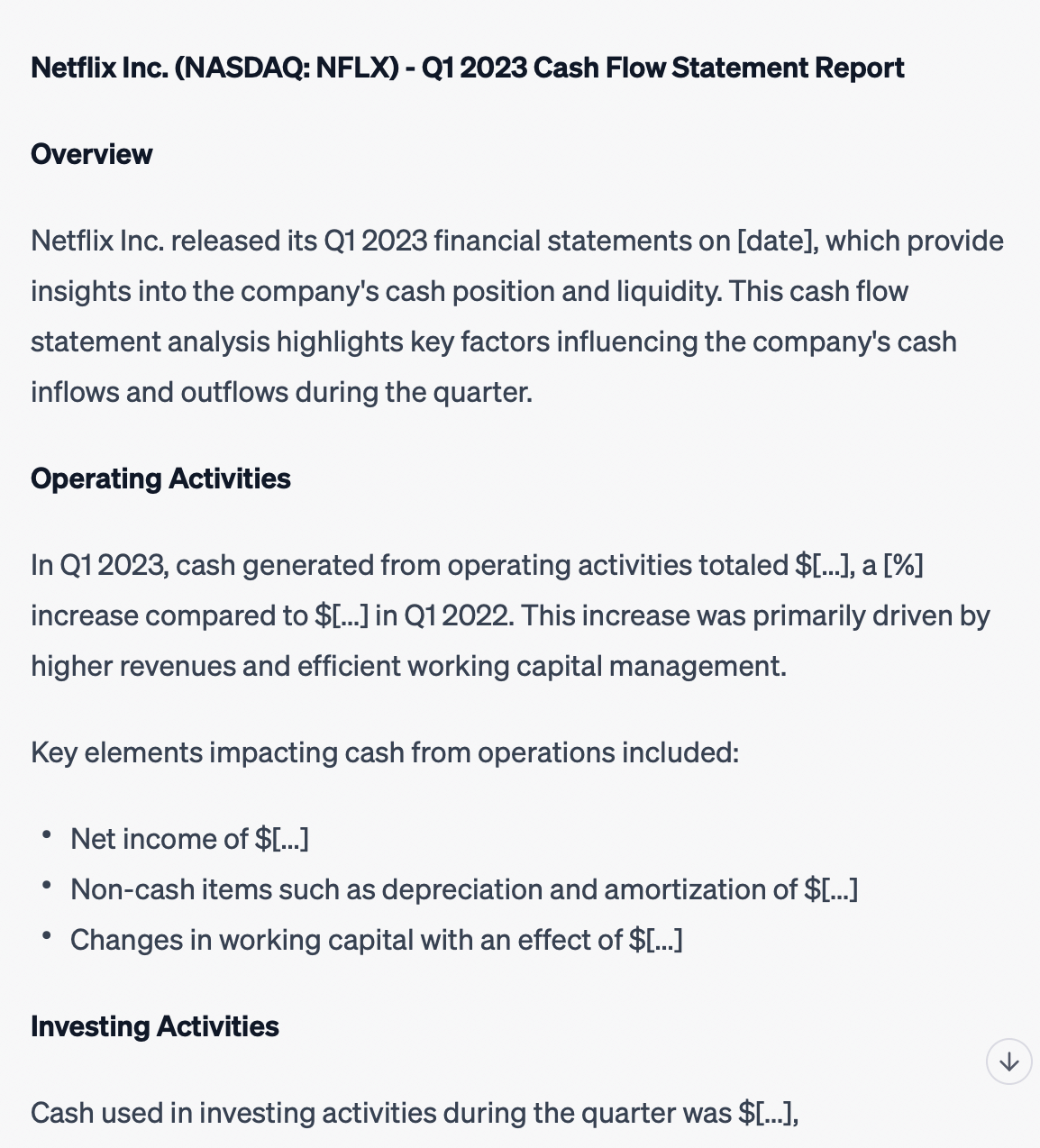
Next, it was Bard’s turn.
We asked Bard the same question and it not only provided an overview of Netflix’s quarterly earnings, but it also created an in-depth analysis, outlook, and further details on cash flow from operating activities to investing activities and more.
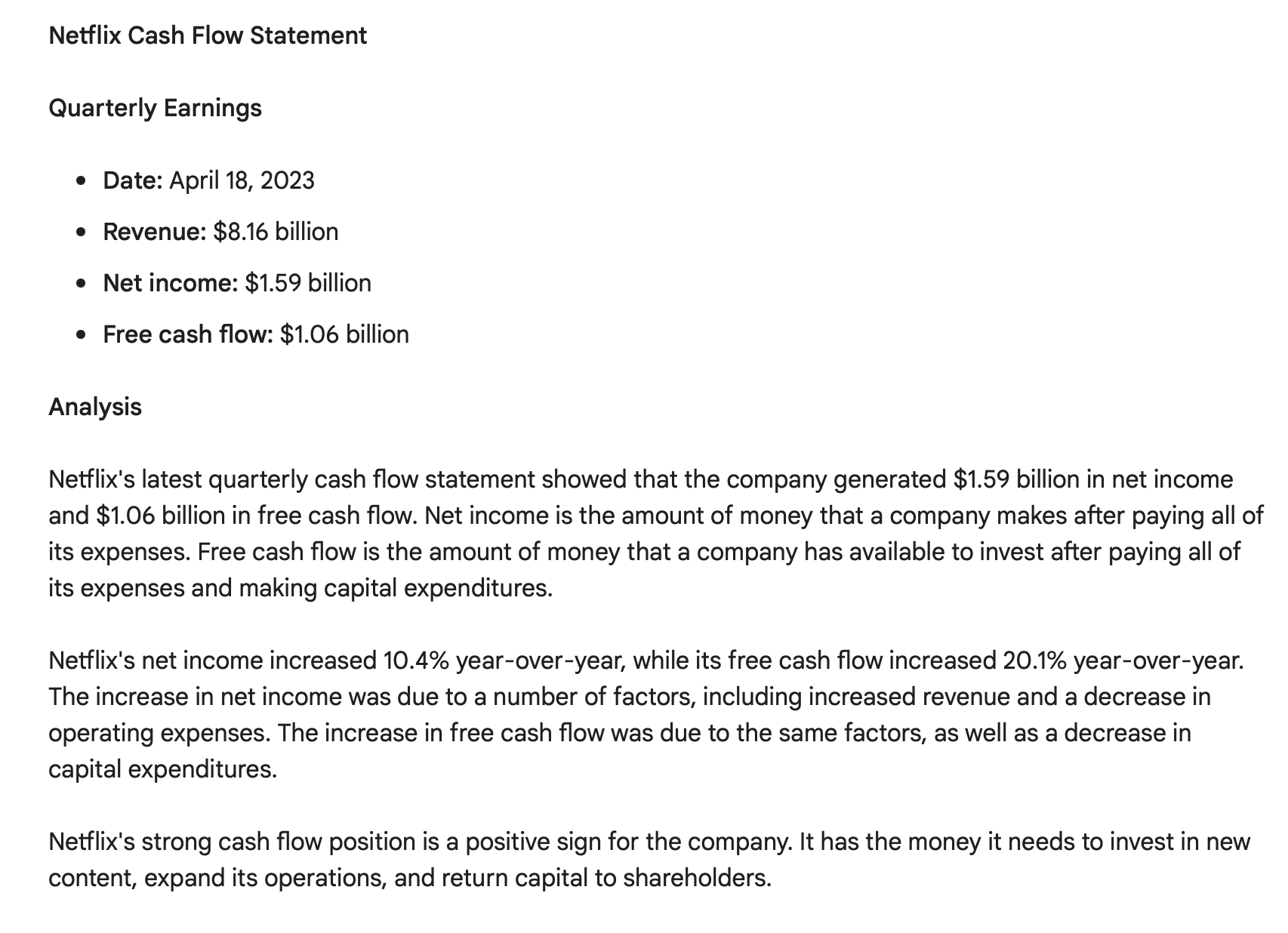
Here is the information Bard provided relating to sources of cash flow, as well as the numbers:
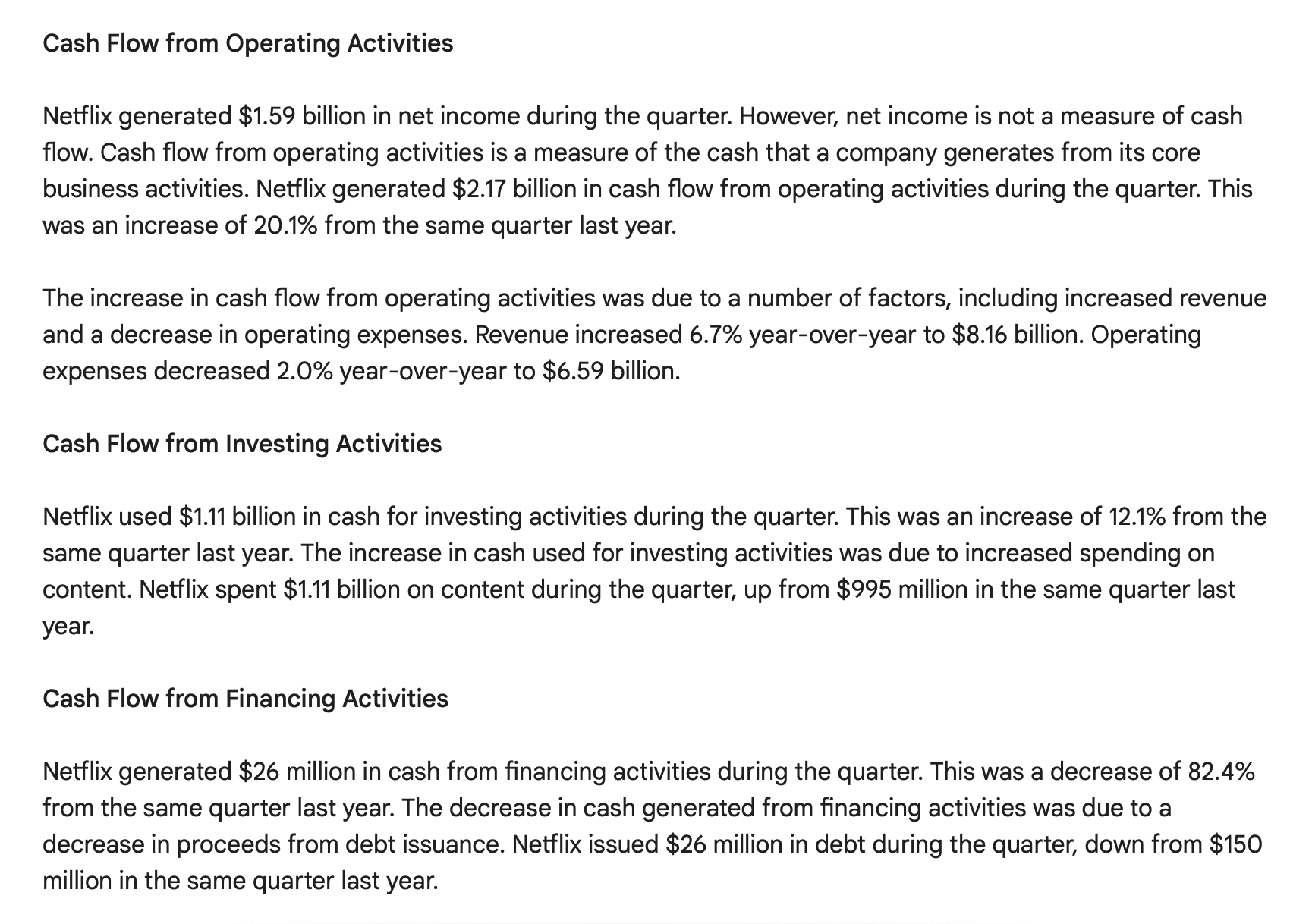
If ChatGPT remains restricted with its lack of internet access, it appears Bard has the upper hand when it comes to providing more in-depth and accurate information.
With that being said, we've noticed ChatGPT has a more engaging tone and is able to be ‘more human’ when it comes to writing in general.
How do I enable Bard on Google?
- Go to the Google Search bar and type "Bard."
- Select "Bard" from the list of results.
- Click on the "Enable Bard" button.
- You will be prompted to sign in to your Google account.
- Once you have signed in, Bard will be enabled.
Bard is now Gemini
Google has updated Bard to Gemini, the latest edition of Google's AI model. Learn more about Gemini here:

FAQs: Google Bard
How does Google Bard work?
Bard is a large language model, also known as a conversational AI or chatbot trained to be informative and comprehensive. It's trained on a massive amount of text data, and can communicate and generate human-like text in response to a wide range of prompts and questions.
Is Bard sentient?
Despite what you might have heard, Bard is not sentient. Bard is a large language model, and isn't capable of feeling emotions or having its own thoughts.
Can I use Google Bard for financial analysis?
Yes, you can use Bard for financial analysis. It can help you with tasks such as researching stocks and investments, analyzing financial data, and generating financial reports.
How much does Bard cost?
Bard is free to use and accessible to everyone.
Further reading:
Learn about Microsoft 365 Copilot and Excel with this article:

Read all about Microsoft Fabric and how you can use it with Data Factory, Synapse Real-Time Analytics, and more here:

Learn how to use ChatGPT with Excel here:

And finally, read all about how to use Copilot with Power BI here:

Subscribe to The Monthly Balance newsletter👇
Stay up-to-date with the latest industry news, updates, blogs, reports, events, and more – all sent straight to your inbox each month.
Subscribe to The Monthly Balance newsletter.




 Follow us on LinkedIn
Follow us on LinkedIn


